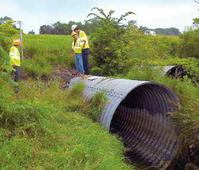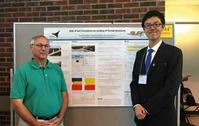Bridging the Unknown
When thinking about bridges, most people envision elevated arches spanning scenic waterways. But as Xiao Zhang learned from his work in the 2015 Summer Undergraduate Research Fellowship (SURF) Program, some bridges are actually underground drainage culverts; they often go unnoticed by drivers on the roads above them.
“If it spans more than 20 feet, the structure is classified as a bridge, which requires regular inspections and a load rating to ensure it won’t fail,” explains Mark Bowman, professor of civil engineering and director of the School’s Bowen Laboratory.
Most bridges are inspected and load rated based on the design plans on file with the Indiana Department of Transportation (INDOT), which owns and maintains more than 5,600 bridges in the state. But what about the nearly 100 bridges in Indiana that don’t have plans on file with INDOT?
“The vast majority are in safe condition, but without a load rating there is some question about the level of safety,” Bowman says. “They are potentially carrying loads above their correct rating, which is a real problem and potential safety issue.”
One such problematic structure — which became the focal point of Zhang’s summer research — is located about two miles north of Peru, Indiana, on U.S. 31, where three underground culverts placed side-by-side lay beneath the road.
Working with Bowman and his graduate assistant, Rafael Armendariz Briones, Zhang examined the role of soil parameters on the loading of buried structures as part of the team’s overall goal to develop protocol for load rating bridges without plans, including those above ground.
“Knowing the contributions and interactions of different soil parameters can significantly reduce the amount of work when rating these structures,” Zhang says. “For buried structures without plans, however, those parameters are unknown.”
Zhang’s study examined three different types of soil from the most porous to the least porous — gravelly sand, sandy silt and silty clay — as well as the structure’s physical characteristics. He then used existing computer software to model the buried culverts and simulate the theoretical structural responses using 2D finite element analysis.
“Thanks to Xiao’s work and subsequent research by Rafael, we’re confident that most underground culverts can be load rated without instrumentation and field load testing, which is much more time consuming and costly,” Bowman says. “He gave us insight into the most critical locations to address and a good start on our next phase of research.”


